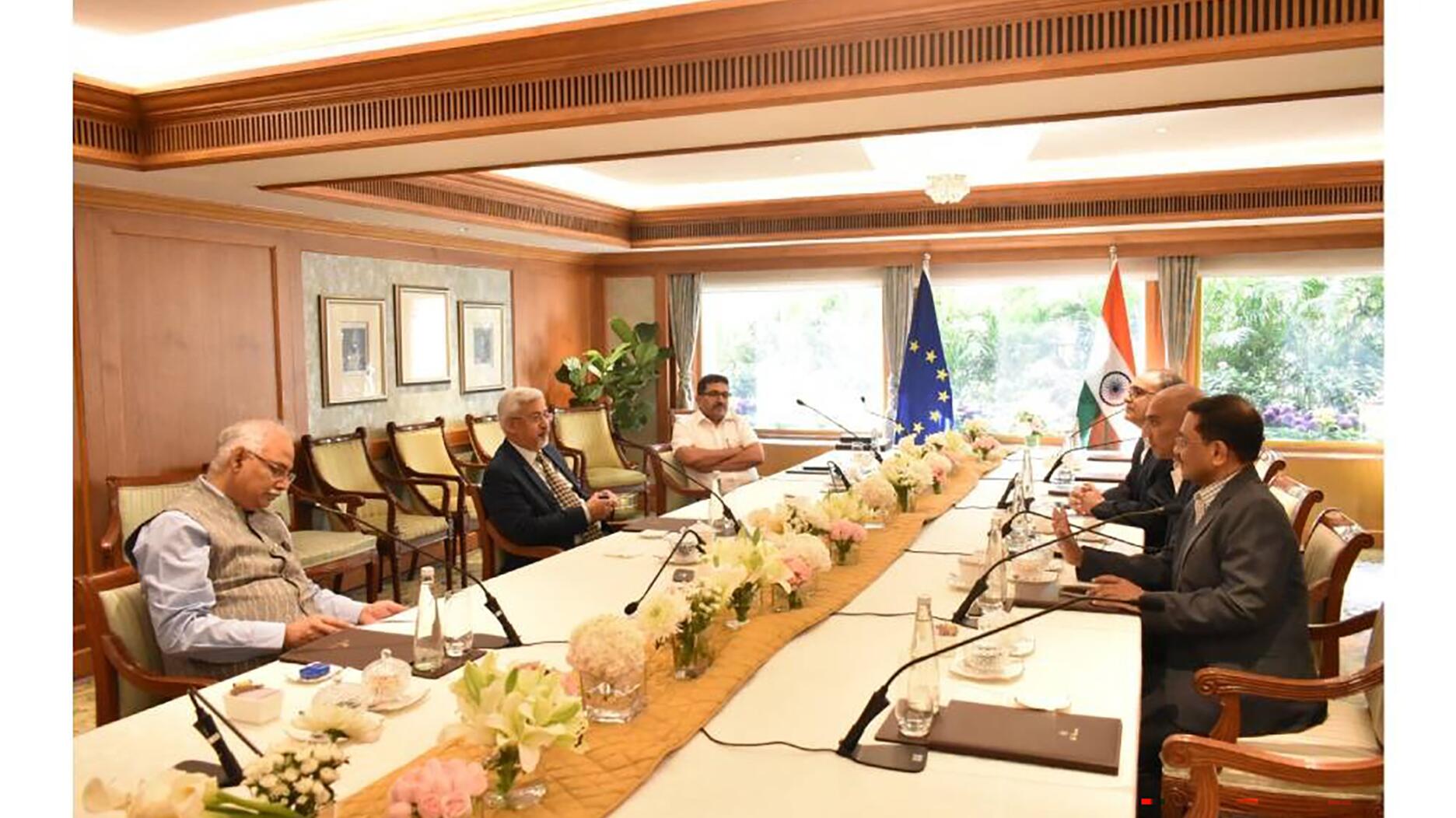Berta de Pablos-Barbier will replace Alexander Lacik at the start of January, two months earlier than expected.
Tariffs Throw Diamond Trade Into Disarray
The 50 percent tariffs on diamonds shipped from India to the U.S. have pushed midstream manufacturers to the edge.

Since Aug. 27, exports of polished diamonds from India to the United States have virtually come to a standstill, impacted by the new 50 percent tariff levied at the point of entry.
India’s Gem & Jewellery Export Promotion Council (GJEPC) Chairman Kirit Bhansali described the steep end-of-August tariff hike as “a deeply concerning development,” that would have “far-reaching repercussions across India’s economy—disrupting critical supply chains, stalling exports, and threatening thousands of livelihoods.”
Just how much tariffs are hurting the diamond trade is evident in the import/export figures GJEPC compiles.
Total cut and polished diamond exports from India to countries worldwide dropped 13 percent to $4.88 billion between April-August 2025, as compared with $5.62 billion in the same period in 2024.
The decline of direct exports to the U.S. was steeper—50 percent in value terms over the same period, from $2.20 billion to $1.08 billion a year ago.
Bhansali said GJEPC has reached out to the Indian government with a request for a package of relief measures to exporters from the gem and jewelry industry in the short term.
Longer term, the organization is ramping up plans to explore and develop new emerging markets for diamonds and diamond jewelry.
For the present, though, uncertainty dominates. No one knows whether the levy will remain at this level and for how long.
An Air of Uncertainty
As of press time, talks on a proposed mega trade deal between India and the U.S. continue, but they have been moving in a zig-zag, stop-start manner. (Latest indications point to them being back on track, with possibilities that talks are nearing a conclusion.)
Diamond analyst Pranay Narvekar of Pharos Beam Consulting LLP said this has pushed the industry into a temporary limbo.
“The lack of clarity hurts. It makes it extremely difficult for anyone to formulate any sort of an action plan other than for the very short term,” he pointed out.
As a result, no one in the industry is looking beyond the next couple of months.
Ajesh Mehta, chairman of GJEPC’s Diamond Panel Committee said, “For now, most of the larger [diamond] cutting units are managing their factories by reducing hours, giving some extra [days off during the regular work week] and also planning on longer vacations during the festival period.”
One of the reasons for this wait-and-watch approach is what industry observers call “frontloading,” or shipping of additional goods based on anticipated projections before Aug. 7, the start date for the 25 percent tax on Indian goods entering the U.S.
The additional 25 percent—a fee U.S. President Donald Trump said was a penalty for India’s purchases of Russian oil—took effect Aug. 27.
Though import-export figures for the April-August 2025 period were down overall, there was a relative surge in diamond exports in July.
Shipments that month shot up by nearly 18 percent, from $910.1 million in 2024 to $1.07 billion in 2025.
Due to this, most Indian manufacturers opine that there are now sufficient stocks held in the U.S. market to meet demand for a few months, a fact confirmed by statements made by some large U.S. importers.
“No one is panicking as of now,” one diamantaire, who asked to remain anonymous, said.
No Short-Term Solutions
There also appears to be a wide consensus that there is little possibility of “re-routing” exports on any significant scale.
“Clearly, origin of a shipment for tariff purposes is considered to be the point where they undergo ‘substantial transformation’. Businesses that have been established over years are not going to take risks for short-term gain,” another diamantaire, who asked to remain anonymous, explained.
Many also pointed out that the closures and job losses being highlighted in the media are not directly related to tariffs alone.
These are a result of multiple changes taking place across the pipeline, including the drop in demand for diamonds—particularly in China—and the plateauing of rough supply, a process that has happened over time.
The increase in tariffs may have accelerated the pace, but only to a limited extent.
A few manufacturers have outsourced part of their production to factories in Africa, the Middle East and a few other centers, but this is only possible for specific types of goods, observers pointed out.
Most units outside India have a limited capacity and can only handle a relatively small increase in workload in a narrow range of sizes and qualities.
It is widely believed that there is no center outside India that has the infrastructure and skills to cut smaller, non-certified goods at present or match India in terms of cost.
A few players expressed fears that the tariffs also will indirectly boost market share of lab-grown diamonds.
They said the lab-grown diamond industry will find it easier to incorporate tariffs into their price, and retailers too may forgo a part of their higher margins on lab-grown goods.
Ironically, this may indirectly benefit Chinese producers.
A Ray of Hope
What will happen once current U.S. stocks are depleted? No one knows, so devising longer-term strategies is not on the agenda for now.
GJEPC’s Mehta said manufacturers in the midstream already operate on very narrow margins.
“There is no way this business can be sustained at current levels in the face of such large tariffs. And making investment decisions in the current scenario has its own risks,” he said.
However, he said the industry is hopeful that an overall trade agreement between India and the U.S. will be reached sooner rather than later, and tariffs on diamonds will either be reduced or totally withdrawn.
GJEPC Executive Director Sabyasachi Ray said the industry draws hope from an Executive Order Trump issued in early September. In principle, it accepts that diamonds are an essential raw material for the U.S. jewelry industry.
“The framework for exempting diamonds imports from tariffs is now in place, though still applicable only to ‘aligned partner countries,’” he said, meaning that India and the U.S. must reach a trade deal in order for diamonds to be exempt from tariffs.
Ripples Across the Pipeline
Ray also pointed out that if tariffs remain in place at current levels, the impact will be felt across the pipeline.
“Our industry is unique. It is one organic whole with each geography having a specific role, and an infrastructure and skilled workforce that has developed over time.”
In the U.S., for example, he noted that jewelry retail is a major industry providing employment and generating revenue, but there are no mines, major factories, or large bourses.
Narvekar, the industry analyst, agreed.
“There a huge amount of value added at the retail end of the pipeline, and even small changes in consumer demand will be amplified as the ripples spread. We have drawn attention to this ‘bullwhip effect’ for the past few years,” he said.
“Unfortunately, these tariffs have come at a time when the industry showed some signs of stabilizing. Demand in the U.S. was steady, and India and the Middle East were doing well.”
Now, tariffs will become what one industry leader called a “tax on consumption.”
Narvekar believes that some price increases are inevitable.
“Even if U.S. jewelry retail remains stable in value terms, volumes are going to fall. This will reverberate back through the pipeline and ultimately will result in a fall in production,” he said.
There is a growing acceptance across the Indian industry that tariffs are here to stay but must be kept at reasonable levels.
“Tariffs and taxes in themselves do not bring business to a halt,” Narvekar said.
When rates are hiked there will be some immediate disruption, but things will settle down over time, albeit at new levels.
“Eventually trade, like water, will find its own level,” he said.
The Latest

Sotheby’s held its first two jewelry sales at the Breuer building last week, and they totaled nearly $44 million.

Winners will receive free registration and lodging for its fourth annual event in Detroit.

How Jewelers of America’s 20 Under 40 are leading to ensure a brighter future for the jewelry industry.

Here are six ideas for making more engaging content for Instagram Reels and TikTok, courtesy of Duvall O’Steen and Jen Cullen Williams.


The honorees include a notable jewelry brand, an industry veteran, and an independent retailer.

Carlos Jose Hernandez and Joshua Zuazo were sentenced to life without the possibility of parole in the 2024 murder of Hussein “Sam” Murray.

Roseco’s 704-page catalog showcases new lab-grown diamonds, findings, tools & more—available in print or interactive digital editions.

The New Orleans jeweler is also hosting pop-up jewelry boutiques in New York City and Dallas.

Set in a Tiffany & Co. necklace, it sold for $4.2 million, the highest price and price per carat paid for a Paraíba tourmaline at auction.

The jeweler’s “Deep Freeze” display showcases its iconic jewelry designs frozen in a vintage icebox.

Take luxury gifting to new heights this holiday season with the jeweler’s showstopping 12-carat sphene ring.

This year's theme is “Unveiling the Depths of the Ocean.”

In its annual report, Pinterest noted an increase in searches for brooches, heirloom jewelry, and ‘80s luxury.

Starting Jan. 1, customers can request the service for opal, peridot, and demantoid garnet.

The 111-year-old retailer celebrated the opening of its new location in Salem, New Hampshire, which is its third store in the state.

The new catalog features its most popular chains as well as new styles.

The filmmaker’s personal F.P. Journe “FFC” prototype was the star of Phillips’ recent record-setting watch auction in New York.

The new location in the Design District pays homage to Miami’s Art Deco heritage and its connection to the ocean.

Inflations, tariffs, and politics—including the government shutdown—were among consumers’ top concerns last month.

“Longtime favorite” presenters, as well as first-time speakers, will lead talks and workshops at the annual event in Tucson next year.

Silas Smith of Meridian Metalworks won the challenge with his pendant that blends Australian and American landscapes.

The sale of the 31.68-carat, sunset-hued stone was part of Sotheby’s first series of events and auctions in Abu Dhabi.

Most customers who walk into your store this month have made up their minds. Your job is to validate their choice, Emmanuel Raheb writes.

The collection features characters and motifs from Ukrainian folklore, including an enchanted mirror and a magic egg.

MatrixGold 3.11, the newest version of the jewelry design program, offers more flexibility, precision, and creative control.

The pavilion will be part of the 2026 JA New York Spring show, scheduled for March 15 to 17.



























